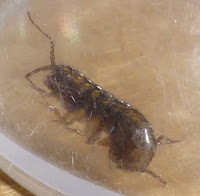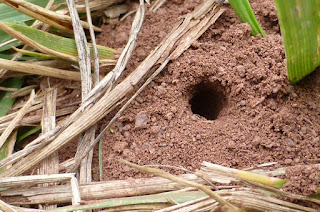Wednesday 9 Sept 2015
South of the city centre alongside Riverside Valley Park is the old paper mill at Countess Wear.
Mill buildings have probably been present here since Mediaeval times. Originally for grinding corn, the mill was thought to switch to paper manufacturing in 1638, making paper from linen rags. In C18 and C19, high quality paper was made there for newpaper and banknotes. The present building is the result of reconstruction after a fire in 1816. The mill at its height employed some 200 people around the 1850s, closing in 1885.
Since Grade II listed, the roof and wall tops were restored in 2008 to protect the remaining structure.... And as part of that project, a large bat loft was installed, along with three woodcrete bat boxes in the unroofed section. As well as these bat bespoke features, there are many nooks, crannies and cavities around the old walls and surrounding woodland, all ideal for roosting bats.
 |
| Inside the Mill for 2013 check - the bat loft is the large structure in the rafters |
That's in theory anyway, but would anyone be at home? To find out requires a long ladder, a head for heights, a torch, and a bat licence. We last checked the site on 23 Sept 2013: a Brown long-eared bat was in the special loft, and a white-tummied Natterer's bat was roosting in a cavity in the wall, the tips of its pointy ears characteristically folded over at rest. Bat detecting later on recorded many pipistrelles and occasional fleeting horseshoe bats flying by.
This time there was a scatter of bat droppings in the bat loft, sign of some use. In the unroofed section were a number of holes in the brickwork also with bat droppings, and in the Natterer's cavity from 2013, a Daubenton's bat. There was also evidence that the woodcrete bat boxes had been adopted - by a Soprano pipistrelle.
It's now more widely known that only fairly recently in the 1990s was the pipistrelle bat discovered to be two separate species, based in part on their echo location calls: common or 'bandit' pipistrelles at 45 kHz, and 'soprano' pipestrelles higher at 55 kHz. This is straightforward with a bat detector, but seriously much less so in the hand: they look very similar indeed.
A diagnostic feature is that a particular wing vein in the soprano pip has a simple 'Y' shape, whereas this is more branched and complicated in the common pipistrelle. Also, males, like the one we found, have gingery fur around their male bits. This was one of this year's young, with pale translucent ends to finger bones where these join but are not yet fully calcified. At 4.5g, it had a little fattening up to do for hibernation, but with a forearm of 30.5mm was adult size. For the time of year, it was also in fine breeding condition; let's just say one could tell.
 |
| Paper Mill pip, 9 Sept 2015 |
Safely returned to the batbox, next on to the woodland to check the bat boxes there. The woodland seems old and well established, but this was once an intensively industrialised mill area extending over 2 hectares, with riverside berths for the import of linen from Holland, troughs for fermenting rags, and coal stores from when the mill converted to using steam power and woodpulp. The remains of brick structures are still dotted about the hazel coppice stools and mature trees that have grown up since.
 |
| Greg checking bat boxes, from 2013 check |
This is where we stopped for the evening. We'll return to take an inventory of the boxes and make some box repairs. A remote bat detector with a month's battery power was also left in the bat loft to record any batty visitors. There are likely to be further bat surveys and bat projects at the site in the future; anyone interested can find out more by joining Exeter City Bats, link below.
Many thanks to Jo and Ruth for bat-licensed supervision and Chris from Exeter City Council.
Info about Exeter City Bats and the Exeter Big Bat Survey 2014-15
https://www.facebook.com/Exeter-City-Bats-223297294481957/timeline/
http://bigexeterbatsurvey.edublogs.org/
Info about UK bats, including Soprano and common pipistrelle, Daubenton's, Natterer's & horseshoe bats
www.bats.org.uk/pages/uk_bats.html
Info about Countess Wear Mill
www.britishlistedbuildings.co.uk/en-481015-countess-weir-paper-mill-devon#.VfWBqM6sN3U




















